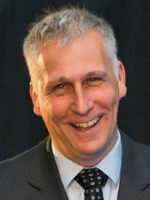Plenary Sessions
Friedlander Lecture: Airborne Ultrafine Particles and Nanomaterials: Adverse Effects on the Respiratory System and Beyond
Flemming R. Cassee
Dutch National Institute for Public Health and the Environment (RIVM), Bilthoven, the Netherlands and Institute for Risk Assessment Studies Utrecht University, Utrecht, the Netherlands
The adverse effects of air pollution on respiratory and cardiovascular health have been established in a series of major observational studies. Even short term exposures to particulate matter (PM) pollution have been associated with marked increases in cardiovascular morbidity and deaths from myocardial ischemia, arrhythmia and heart failure. However, these observational data are limited by imprecision in the measurement of pollution exposure, and the potential for environmental and social factors to confound these apparent associations. Much attention has been paid to the role of tail pipe emissions on pulmonary and cardiovascular toxicity. Examples will be shown on the implications of particles traps, catalytic converters and changing fuels (biodiesel) on the toxicity and health risk associated with tailpipe emissions. Although the focus in the past few years has been on road traffic emissions, mainly from diesel engine, PM is emitted from other sources like brakes as well as well as e.g. aviation. Some sources have been shown to have a much higher oxidative potential compared to diesel soot. This will also include BioPM, a suspension of particles containing living microorganisms or parts thereof released in air. Very little is known as to what extent such effects are different for PM obtained from other sources. Similarities and differences with engineered nanomaterials will be discussed. For a causal association to have scientific credence, a clear mechanism must be defined. Oxidative stress has been suggested as a key aspect leading to cardiovascular toxicity and worsening of diseases. This presentation will provide information on the effects of inhaled ultrafine particles and nanomaterials (including the role of physical and chemical properties) on the respiratory system as well as on cardiovascular health, neurodegeneration and reproduction.
Biosketch:
Flemming Cassee, inhalation toxicologist since 1995, supports government authorities by coordinating and conducting research and providing advice to policy makers. His research focus is on aimbient particulate matter (PM) and airborne nanomaterials. He is a professor in Inhalation Toxicology at the Institute for Risk Assessment Sciences at the Utrecht University, the Netherlands. He also leads the Inhalation Toxicology unit at the National Institute for Public Health and the Environment (RIVM) of the Netherlands. He is Editor-in-Chief of Particle and Fibre Toxicology, Past-President of the Dutch Society of Toxicology, Past-President of the Inhalation and Respiratory Speciality Section, and President Elect of the Nanotoxicology Specialiy Section of the USA Society of Toxicology. He is also part of the coordination team of the EU Nanosafety Cluster and an advisor of the World Health Organization with respect to air pollution.

What to do about the Toll Biomass Burning is taking on our Health, Indoor Environments, and Climate
Shelly L. Miller, University of Colorado Boulder
Biomass burning emissions include those from wildfires, controlled and agricultural burns, and burning of biofuels for heating and cooking. Emissions of aerosols and gaseous pollutants from burning biomass have major impacts on air quality, public health and climate at spatial scales that range from indoors to global and impacts are felt in developed and developing countries alike. Exposures are experienced mostly indoors due to the time we spend at home, so the focus of this presentation will be on indoor-related impacts. Particulate matter is of special interest because of the large quantity produced during biomass combustion and because of its known adverse human health outcomes, including increased hospitalizations, mortality, respiratory symptoms and infections, and inflammation. Climate change is increasing the frequency of wildfires and area burned; also, biomass burning is linked to changing the climate. This presentation will detail the latest science on impacts of biomass burning on indoor environments including wildfire impacts on residential exposure and biofuels combustion in homes in developing countries. Additional comments will include indoor cooking emissions from food preparation because this is a significant source of exposure to aerosols and toxic gases. A discussion of control strategies to reduce exposure will include how to effectively reduce exposures with ventilation, window opening, air cleaners, alternative fuels and cleaner stove technology.
Biosketch:
Shelly L. Miller, Ph.D., is a Professor of Mechanical Engineering and faculty in the Environmental Engineering Program at the University of Colorado Boulder. She holds an M.S. and Ph.D. in Civil and Environmental Engineering from University of California, Berkeley and a B.S. in Applied Mathematics from Harvey Mudd College. Dr. Miller teaches about and investigates urban air quality and works diligently to understand the impact of air pollution on public health and the environment. She has published over 60 peer reviewed articles on air quality, authored a Chapter on Indoor Air Quality in the Environmental Engineering Handbook, is an active scientist on twitter, and publishes open access as often as possible.

Soot Formation and Chemical Evolution during Combustion
Hope A. Michelsen, University of Colorado Boulder
There are substantial gaps in our understanding of the mechanisms controlling soot inception, particle growth, and chemical evolution during combustion. The first steps in soot formation involve the transition of gas-phase hydrocarbon precursors to physically or covalently bound complexes. These complexes are known as “incipient particles”, and the search for their formation and growth mechanisms is a subject of active research [1-3]. These incipient particles undergo further particle growth, generating liquid-like hydrocarbon particles, which eventually reach sizes in the range of 10-50 nm, known as “primary particles” [1-5]. As these particles grow, they also lose hydrogen, solidify, and agglomerate into loosely bound clusters. Under high-temperature conditions, they become graphitic, covalently bound aggregates with a dendritic structure. Soot aggregate sizes, primary-particle sizes, and volume fractions grow as particles age in the flame [4,5]. At high temperatures in the presence of oxygen, the aggregates fragment [6,7], and the primary-particle sizes and volume fractions decrease through oxidation [4,8]. There is a poor understanding of the mechanisms by which particles undergo these transitions and the parameters that influence them.
This talk will describe our current understanding of soot formation and the scientific evidence that supports this understanding. This talk will also cover the gaps in our understanding of soot chemistry, some reasons for these gaps, and what we may need to do in order to bridge these gaps and develop more insight into soot formation and evolution.
[1] H. A. Michelsen, Proc. Combust. Inst. 36, 717 (2017).
[2] H. Wang, Proc. Combust. Inst. 33, 41 (2011).
[3] K. O. Johansson, M. P. Head-Gordon, P. E. Schrader, K. R. Wilson, and H. A. Michelsen, Science 361, 997 (2018).
[4] R. A. Dobbins, and C. M. Megaridis, Langmuir 3, 254 (1987).
[5] R. Puri, T. F. Richardson, R. J. Santoro, and R. A. Dobbins, Combust. Flame 92, 320 (1993).
[6] K. G. Neoh, J. B. Howard, and A. F. Sarofim, Twentieth Symposium (International) on Combustion 20, 951 (1985).
[7] C. A. Echavarria, I. C. Jaramillo, A. F. Sarofim, and J. S. Lighty, Proc. Combust. Inst. 33, 659 (2011).
[8] K. O. Johansson, F. El Gabaly, P. E. Schrader, M. F. Campbell, and H. A. Michelsen, Aerosol Sci. Technol. 51 (12), 1333 (2017).
Biosketch:
Dr. Hope A. Michelsen has been a technical staff member in the Combustion Research Facility at Sandia National Laboratories since 1999. Her research program focuses on developing and using X-ray, optical, mass spectrometric, and theoretical techniques for studying the chemistry and characteristics of combustion-generated particles inside the combustor and their abundance in the atmosphere. Her research experience includes gas-surface scattering experiments, atmospheric modeling, soot-formation studies, combustion-diagnostics development, atmospheric black-carbon measurements, and greenhouse-gas source attribution. She received an A.B. in Chemistry from Dartmouth College and a Ph.D. in Chemistry with a minor in Physics from Stanford University. She completed an NSF postdoctoral fellowship at Harvard University in Earth and Planetary Sciences and was a staff scientist at Atmospheric and Environmental Research, Inc. before joining the technical staff at Sandia. She will join the faculty as an Associate Professor in the Department of Mechanical Engineering at the University of Colorado in Boulder in August 2019. Dr. Michelsen is a Fellow of The Optical Society, an inductee of the Alameda County Women’s Hall of Fame, and an Associate Editor of the Proceedings of the Combustion Institute.

AEESP Lecture: This is Getting Dynamic: How the Volatility Basis Set Informs Particle Formation and Growth
Neil Donahue, Carnegie Mellon University
A large fraction of atmospheric nanoparticle growth is driven by condensation of organic compounds. Especially below 10 nm there is a fine dance between curvature induced volatility enhancement (the Kelvin effect) and mixing (the Raoult effect). In addition to Koehler and nano-Koehler behavior, the distribution of organic volatility over a very wide range plays a key role in particle growth. A major contribution comes from the new (to atmospheric chemistry) process of peroxy-radical auto oxidation, which forms highly oxygenated organic molecules (HOMs) rapidly during the initial stages of oxidation. In the CERN CLOUD experiment we have been able to measure the full distribution of organic products in both the gas and particle phases, establishing closure between observed vapor concentrations, growth rates, and particle composition at temperatures ranging from 250 to 320 K. Finally, we observe interesting and potentially critical couplings between different organic peroxy radicals that may have major implications for the behavior of atmospheric organics in low-NOx environments. All of these issues are well-suited to a dynamical version of the Volatility Basis Set that resolves peroxy-radical chemistry and provides a framework to describe the dynamics of organic particle nucleation and growth.
Biosketch:
Neil Donahue was born in Pittsburgh and traveled the world before returning to Pittsburgh to take up a position at Carnegie Mellon University in 2000. He has an AB in Physics from Brown University, a PhD in Meteorology from MIT, and work at Harvard for a decade conducting research in gas-phase kinetics and oxidation of organic compounds, with notable contributions to alkene ozonolysis. At CMU he joined the thriving air-quality engineering group and with them formed the Center for Atmospheric Particle Studies (CAPS), which has become one of the world's leading atmospheric aerosol research groups. In addition to rich collaborations within CAPS, he has continued to collaborate around the world, including bringing multiple oxidation chambers together to study organic aerosol formation (the MUCHACHAS experiment) and more recently joining the CLOUD consortium at CERN. He is known as the father of the Volatility Basis Set and has received the Pittsburgh and Esselen awards from the American Chemical Society, the Carnegie Science Award for the Environment, and is a Fellow of the American Geophysical Union.

Dates to Remember
July 19, 2019
Early Bird Registration Deadline
Late Breaking Poster Abstract Deadline
September 19/September 23, 2019
Hotel Sleeping Room Reservation Cut-off (Two Hotel Options)
October 14-18, 2019
AAAR 37th Annual Conference
Location
Oregon Convention Center
777 NE Martin Luther King Jr Blvd.
Portland, OR 97232
Hotels
Doubletree By Hilton
1000 NE Multnomah Street
Portland, OR 97232
Quality Inn Downtown Convention Center
431 NE Multnomah Street
Portland, OR 97232
Conference Registration Fees
| Registration Categories |
Early Bird Received By July 19, 2019 |
Advance Received Between July 20 and August 12, 2019 |
On-Site Received After August 12, 2019 |
| Regular | $609 | $699 | $792 |
| Early Career | $481 | $552 | $621 |
| Retiree | $185 | $185 | $276 |
| Student | $185 | $185 | $276 |
One-day registrations are also available. Click here for more information.
